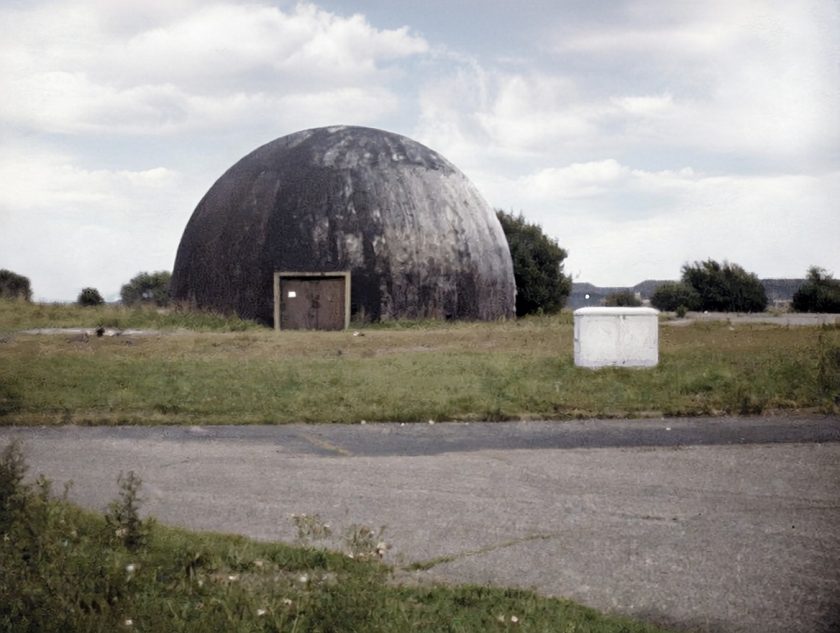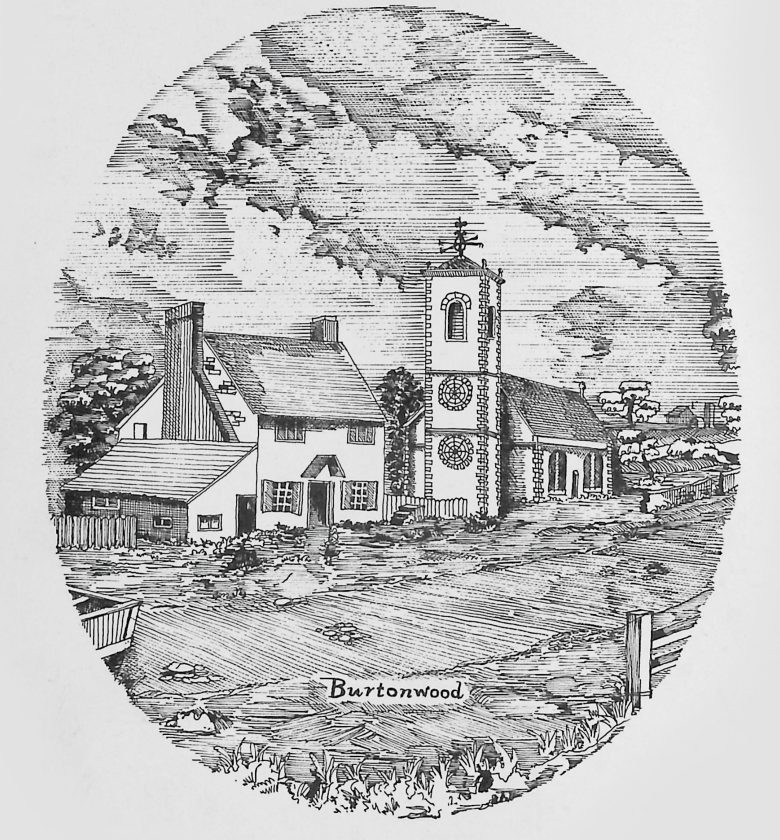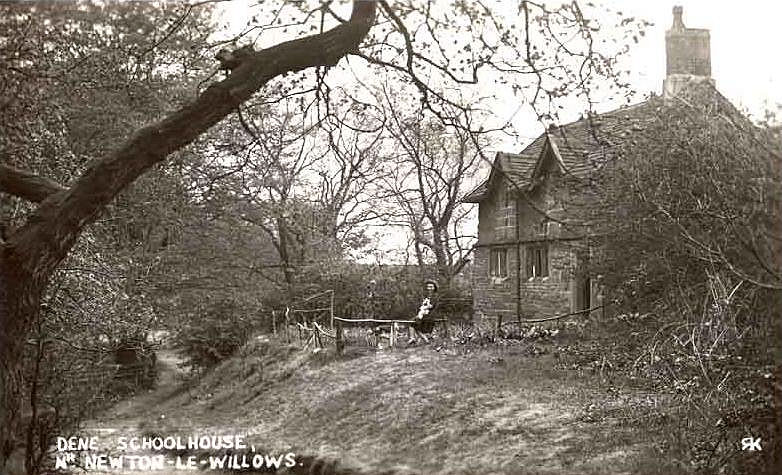Newton in Makerfield Is a populace and rapidly – improving locality, containing several important industrial and manufacturing establishments. The town of Newton consists chiefly of one long and broad street, pleasantly situated on a gentle eminence, and commanding extensive and panoramic views. It is about five miles from St. Helens, seven from Wigan, and near the important Railway Station of Newton Bridge. The extensive printing establishment of Messrs. McCorquodale is near the station, and in its immediate vicinity its a first- class Hotel, while the fine old Corn mill on the brook, a few yards distant, seems to preserve for the spot a good deal of charm of a quiet and homely serenity. At Newton, a stupendous work, on the London and North Western Railway is carried over the valley by four lofty arches, stretching on each hand from vast embankments. Branch lines from Warrington, Wigan, Bolton, etc. form their junction in this parish with the Manchester and Liverpool railway; and Parkside, half-a-mile to the east of Newton, is rendered memorable as the spot upon which the Right Hon. William Huskisson, M.P. for Liverpool, encountered the fatal accident which terminated his life, on the day of opening. A mural tablet, raised to his memory near the spot, where the wheels of the carriage passed over his limbs, serves to record the sad event.
Amongst the other large works carried on in this parish, may be mentioned, the extensive London and North Western Railway Wagon Works, established in 1853, at which above 1,000 hands are employed; the Paper Manufactory of Messrs. Gillespie and Mason, and that of Messrs. Rose and Gibson; the Vulcan Iron Company, of which W.F. Gouch, Esq. is manager; the Foundry of T. & T. Vicars, who are also manufactures of Self-stoking Smokeless Furnaces; and the Sugar Refining Works of Joseph P. Birley, Esq., first established here in 1854. Here also a Glass Bottle Manufactory, but there are no Chemical Works in the parish
In Saxon times, Newton was of sufficient importance to give name to one of the hundreds of Lancashire, and it retained this distinction even in the reign of the Conqueror. Who the first baron of Newton was, is not quite clear, but the title seems to have descended from the Banastres to the Langtons, and that one of the latter family obtained charters for markets, fairs, and free warren, 29th Edward L. Cardinal Langton, who occupied a conspicuous position in the reign of King John, when the barons compelled that monarch to concede the great charter of liberty, was of this family. About the year of 1620, the manor was carried to the Fleetwoods, by the marriage of an heiress of Sir Thomas Langton to John Fleetwood. An heiress of the family married Sir Peter Legh, of Lyme, and about two centuries ago, the principal property in Newton, Haydock, Golborne, Lowton, and other places, with the honor of Mackerfield, became vested in the family of Legh, by purchase from Sir Thomas Fleetwood. The market, which had fallen into disuse, seems to have somewhat revived; but the baronial title has shared the fate of all feudal tenures. Courts baron and leet are held here annually, in April and October, by the agents and bailiff of William John Legh, Esq., lord of Newton
Newton returned two members to parliament, from the first of Elisabeth till 1632, when it was disenfranchised by the reform bill. The nomination was in the lord of the manor, until 1620, and afterwards the franchise became vested in the free burgesses or persons possessing freehold estates in the borough, to the value of 40s. a year and upwards, of whom there were about sixty who claimed to vote; but, the burgage enures being chiefly in the lord of the manor, the election was as much in him after, as it was before, the right came nominally into the hands of the burgesses. The return of members ceased with the election of 1831, but Newton is still a polling place for the election of members to represent South-west Lancashire. Two annual fairs, of two days each, are held here – the first on the 17th and 18th of May, and the second on the 11th and 12th of August – principally for horses, cows, and sheep. The sport of the turf and the cockpit formerly prevailed at Newton, to a considerable exten t; and races still take place annually, a little distance from the town. Newton races are held the week following those of Manchester, and are generally well attended. The grand stand is a handsome and convenient building. Several neat cottages have been erected on the road to the race-course, and there is about the town an air of quiet and calm gentility
The parish church, dedicated to Emanuel, is a neat building of red sandstone, in the early Gothic style, and was erected in 1841. Newton was made a distinct parish and rectory, 4 Vict. cap.9. The church is situated at Wargrave, a pretty village about three-quarters of a mile from Newton. The living, a rectory, is the gift of the Earl of Derby, and incumbency of the Rev. John Whitely, M.A. An Episcopal Chapel existed in Newton from an early period. This chapel was enlarged in 1819, and again in 1834, at a cost of ?1,500. and reopened in November, 1835. It is now a district church and dedicated to St. Peter. The living is a perpetual curacy, in the gift of W.J.Legh, Esq. and incumbency of Rev. Thomas Whitley, M.A. Service is performed every Sunday in the Church Scool at Earlestown. The Independent Chapel in Crow Lane, is a substantial stone building; the interior is neatly ornamented, and the sittings are well arranged. Rev. James Allatt, minister There is a school, in connection with this place of worship; and a grammar school, founded by Peter Legh, has an endowment of nearly ?60. a year. The National school, in connection with the parish church, stands at Wargrave. The Wesleyan Chapel, erected about seven years ago, is a large building, and underneath is a school room for day and Sunday scholars. The Catholic Chapel at Crow Lane is very appropriately fitted up, but is only capable of accommodating about 350 persons. It was commenced in 1861, and consecrated December 4, 1864. Its dedication is to SS. Mary and John, and is now under the pastoral care of the Rev. James Lennon. The Catholics have also a school here.
At a place called Red Bank, on the verge of this parish, a detachment, of Cromwells army defeated a party of Highlanders, in 1648. The greater part of the prisoners are said to have been hanged in a field near the scene of the action; it still bears the name of Gallows Croft; but may it not have been the site of the original baronial gallows, when the baron of Mackerfield exercised that power: About half-a-mile to the east of Newton, is the ancient barrow known as Castle Hill, romantically situated on elevated ground, at junction of t wo streams, whose united waters form a brook which flows past the town. The sides and summits of the mound are covered with venerable oaks. It is bell-shaped and the circumference, at the base, is 320ft., and at the top, 226ft., its height is 17ft. On excavating here is 1843, a chamber, 22ft.long, 2ft. high, and 2ft. broad, was discovered; its floor being covered with what appeared to be a mixture of half burned wood ashes, animal matter, and calcined bones, but no armour or ornaments were found.
It has been conjectured that the “Bloody Stone,” which was in Newton Park, might be the place where the Welsh Knight, who had usurped the Castle of Haigh, and the Lady Mabel, was killed, by the real lord, Sir William Bradshaigh, on his return from the Holy Land; but other writers assert that it was a Scotch lady, who was beheaded by Oliver Cromwell, after the fight at Red Bank. The Rev. E. Sibson, facetiously says, “The Castle is said to be haunted by a White Lady, who flits and glides, but never walks; who is sometimes seen at midnight, but never talks.” Whether this immediate neighbourhood was ever of great importance which tradition assigns to it, would now, be difficult to determine; but that Newton was a royal manor before the time of William the Conqueror, and that Culcheth has been regarded, by good authority, as the site of many synods of the early Saxon Church, there can be no reasonable doubt. Several Charters are dated Caelchyth, and the place is still called “Kilsha,” by many of the inhabitants. It has been conjectured that, on the death of Oswald, whose palace is said to have stood at Wood End, near Hermitage Green, the royal residence may have been transferred to another place – hence the name Newton, or Newtown, or Ville and the Castle Hill may have formed part of the enclosure of the Kings residence. Although it is recorded in history, that Oswald was slain at Maserfield, in Shropshire, on the first of August, 642, yet, we cannot be quite sure that such is the fact; for several historical records, of much more modern times are not merely inaccurate, but absolutely false. An instance of this will be given a few pages forward. Local traditions are always far more worthy than prejudiced writings.
Populations of the parish in
1801, 1455
1811, 1589
1821, 1643
1841, 3130
1851, 3719
1861, 5909
1871, 9000
Copied from the Local 1871 Directory by P. Mannex & Co



